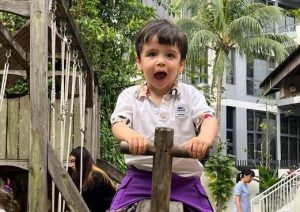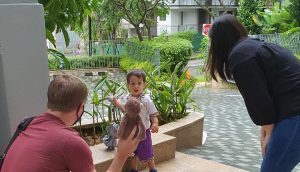
8 Tips For Travelling With Young Children
Travel is a wonderful way to broaden and expand the minds of young children, and a great way to create memorable experiences for the family. It can be very challenging, but with proper planning and preparation, has the possibility to be a terrific experience for all involved! Teacher and seasoned mummy traveller Ms. Fatin shares 8 practical tips she has gleaned from travelling with her son Andika on how to travel with young children comfortably and without stress. Andika at Telaga Tujuh (Seven Wells) Waterfall in Langkawi, Malaysia 1. Choose child-friendly destinations Do consider destinations that offer activities and attractions suitable for the whole family. Look for family-oriented attractions such as parks, beaches, theme parks, water parks and zoos. Discuss the trip with your children to build excitement and anticipation. Visiting Penang’s Jurassic Research Centre, Rainbow Skywalk and Boutique Aquarium 2. Book child-friendly accommodation Book accommodations with child-friendly amenities such as hotels with kid’s clubs, family rooms, playgrounds, swimming pools and in-room kitchen facilities. Most importantly, these accommodations should be situated in safe, family-oriented zones. Be sure to research and read reviews before you book. In-room kitchens and kids playgrounds (water play areas preferred!) are highly recommended 3. Research transportation options If you’re travelling by air, check the airline’s policies regarding travelling with children such as baggage allowances and onboard amenities. For a long trip, utilise every pit stop opportunity for toilet breaks and ‘stretching’ walks. This will help your children to work off their energy before sitting through the next stretch of the journey, which can be a difficult task for young children. 4. Pack efficiently and check-in as much as possible Evaluate your travel destination and the facilities available. Will you have access to laundry facilities? Are diapers or other supplies readily available? Consider whether you can purchase items at your destination instead of packing everything. Research and engage equipment rental services at your destination, for bulky items such as strollers and car seats. Use compression bags or packing cubes to organise clothing and minimise bulk. Rolling clothes instead of folding them can also save space. Prioritise essential items and leave out non-essential or bulky items whenever possible. Check-in as much baggage as possible, because the last thing you want is to fumble with baggage at the departure hall whilst managing your excited children. Andika working on Numeracy cards from House on the Hill’s Math It Write whilst on the ferry 5. Plan your carry-on baggage well When travelling with young children, prioritize packing essential items such as diapers and formula (if applicable), spare clothing and medications in your carry-on baggage. This ensures you have immediate access to these items when onboarding, in case you need them. Pack some age-appropriate, quiet activities and entertainment to keep your children engaged for onboarding (e.g. colouring materials, busy books, fidget toys such as Rubiks cube, spinners and pop-its, card or board games). Pack their water bottle and lots of light snacks. Consider downloading some offline child-friendly apps or movies onto your devices to use as a last resort in a pinch! 6. Allow For Ample Time And Flexibility Leave early for everything! The last thing you want to do is to rush your children during a vacation. Children often have their own pace so factor in extra time for everything – whether you are getting to the airport, exploring attractions or simply getting ready in the mornings. Having a more relaxed schedule can reduce stress and allow for spontaneous breaks. Children thrive when they feel secure and comfortable so maintain a positive attitude and be patient. Expect the unexpected and be ready to adjust your plans accordingly. Flexibility is key to ensuring everyone’s happiness during the trip. 7. Pre-book attractions and services To avoid long queues and disappointment, pre-book tickets to popular attractions such as theme parks or shows. This will help you save time as you and your children can enjoy your itinerary with minimal queueing and waiting. BONUS TIP: Helping young children overcome ear popping at take-off Sucking and swallowing Swallowing will help to equalize the pressure in the ears and can prevent or alleviate discomfort. If your child is an infant, breastfeeding or using a bottle during take-off can be helpful. For older children, encourage them to swallow frequently during take-off. If they are unable to imitate the swallowing action independently, provide them with a pacifier, lollipop or a drink with a straw. For children who can chew, offer your child snacks that require chewing, such as crackers or dried fruit. This can be an effective way to relieve ear pressure as chewing helps stimulate saliva production, promoting swallowing and equalizing the pressure. Pretend to yawn For older children, encourage them to yawn by demonstrating it yourself or by suggesting fun ways to mimic yawning such as pretending to be a lion or a big bear. Yawning helps open up the Eustachian tubes which can relieve ear pressure. Distraction techniques Engage your children in activities or games that distract them from the discomfort and make the time pass more quickly (refer to point 5 on ‘Plan your carry-on baggage well’ for ideas). Nasal sprays Consult with your child’s pediatrician before using nasal sprays but in some cases, they may be recommended to help open up the nasal passages and improve Eustachian tube function. This can aid in equalizing the ear pressure. Earmuffs / earplugs For some children with sensitive ears or hypersensitivity issues, they may experience a significant amount of discomfort during take-off. Consider using earplugs or earmuffs designed for children. These can help reduce the impact of pressure changes and make the experience more comfortable for them. Connecting to their travel experiences – the Montessori Way Children thrive on routine. Travelling changes patterns – meal times, rest times, play time. We can help the child adapt to these changes in their routine by preparing them to bring a few things from home – like their favourite toy or book. Involve them in the experiences travel provides. Communicate












